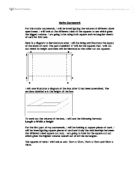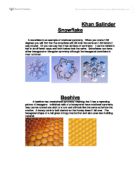Area & Volume Exploration – Component proportional changes
Area & Volume Exploration - Component proportional changes Question 2: Suppose that you are required to design an open steel tray from a sheet of steel that measures 120cm by 80cm by cutting squares from each corner, and folding to form a tray. What size should the squares be cut from each corner of the sheet so that the maximum volume is obtained for the tray. Height = x cm Width = 80cm - 2x cm Length = 120cm - 2 x cm The task is to find the optimal size of the squares that need to be cut out of the corners in order to find the maximum obtainable Volume inside the tray once it has been folded. To work this out there are a number of different methods for doing this. One method is Trial and Improvement. Trial and Improvement Height (Value of x cm) 2 x cm Length (cm) (120cm - 2 x cm) Width (cm) (80cm - 2x cm) Volume (cm3) (120x - 2 x 2)?(80 - 2x) +/- 5 0 10 70 38'500 7.5 5 05 65 51'187.5 + 0 20 00 60 60'000 + 2.5 25 95 55 65'312.5 + = 5 30 90 50 67'500 + 7.5 35 85 45 66'937.5 - There is no point in increasing x any more than 17.5 as the volume is now clearly decreasing. This means the Maximum volume lies below 17.5. As the volume rises between 12.5 and 15 we know that the maximum volume must lie after 12.5. We can now continue with the trial and improvement table to fin the maximum volume, working only between 12.5 and
Number grids
NUMBER GRIDS 2 3 4 5 6 7 8 9 0 1 2 3 4 5 6 7 8 9 20 21 22 23 24 25 26 27 28 29 30 31 32 33 34 35 36 37 38 39 40 41 42 43 44 45 46 47 48 49 50 51 52 53 54 55 56 57 58 59 60 61 62 63 64 65 66 67 68 69 70 71 72 73 74 75 76 77 78 79 80 81 82 83 84 85 86 87 88 89 90 91 92 93 94 95 96 97 98 99 00 The aim of my investigation is to find the cross product difference of various grid sizes and see what I notice about this. I will try to find out a pattern from when I change the grid sizes. I will get a 10 by 10 table ranging from 1-100 and start off using squares, i.e. 2x2, 3x3, 4x4 e.c.t. I will take the two opposite corners and multiply them together doing the same on both sides, I will take the two final numbers and subtract them from one another, this will leave me with a number, which should be the same for each of the same sized grid shapes. I will place my results into a table and see if I can work out a formula for finding out all the results. 2x2 2 3 22 23 (13x22) - (12x23) = 286-276 = 10 5 6 25 26 (16x25)-(15x26) = 400-390 = 10 77 78 87 88 (78x87)-(77x88) = 6786-6776 = 10 81 82 91 92 (82x91)-(81x92) = 7462-7452 = 10 33 34 43 44 (34x43)-(33x44) = 1462-1452 = 10 In all of the small 2x2 number grids above I have found out that the product of the
Open Box Problem.
Open Box Problem Aim During this project I will be determine the size of the square cut which makes the volume of the box as large as possible for any given rectangular sheet of card. What is an Open Box An open box is to be made from a sheet of card. Identical squares are cut off the four corners of the card, as shown below. The card is then folded along the dotted lines to make the box. [image001.gif] [image002.gif] Names of things needed for investigation I will write-up my investigation in Microsoft Word and all formulae shall be calculated on Microsoft Excel and all table and graph will be produce in spreadsheets again in Microsoft Excel. Structure of investigation 1. Evidence: · Table · Graphs · Formulas 2. Evaluation 1. Evidence To obtain evidence I will be used a series of methods: · Table · Graphs · Formulae Part 1, Square I am going investigate 3 different sizes for the square open box. Once I have obtained all information on the 3 sizes I will look for patterns and try to formulate a rule to work out the largest volume for an open box square. The sizes that I will be using are: 1. 20 x 20 2. 40 x 40 3. 25 x 25 Because it is a square the length = width so, we can write this as L=1W therefore there is a ratio 1:1. I am going to begin by investigating a square with a side length of 20cm. Using
Open Box Problem
In this investigation, a box without a lid must be made from a sheet of card, as shown below. Identical squares must be cut out of each corner and the dotted lines folded along to form the sides of the box. The goal of the investigation is to find out a relationship between the size of the initial piece of card, the size of the identical corner squares and the volume of the resulting open box. This will allow me to say what size corner square will produce the box of the largest volume, for any given rectangular sheet of card. To begin with, I am going to investigate the size of the corner square that must be cut out to make an open box of the largest volume, for any sized square sheet of card. Once I have found the formula that allows me to find this out easily, I will progress to using an initial piece of card that is rectangular in shape. The formula used to obtain the volume of a box is VOLUME = Length * Width * Height (where * is multiplication) To show a simple example of how this formula works with the open box, I will first of all use a initial piece of card that is 20cm by 20 cm, and a corner square (from now on called 'cut-off') of 2cm by 2cm. Once the cut-offs are taken away, the net will look like this. From this we can see that when the dotted lines are folded along, there is a height of 2cm, a length of 16cm and a width of 16cm. Since Volume = Length *
Open Box Problem
Introduction In this project, I am aiming to: . Determine the size of square cut from any given square sheet of card which makes the volume of an open top box as large as possible. 2. Determine the size of square cut from any given rectangular sheet of card which makes the volume of the resulting open top box as large as possible 4 squares were cut from the paper (1 from each corner). It was then folded along the lines (see diagram), to make an open top cuboid. Different size squares being cut from the paper each time resulted in a different volume. I spent time ring to calculate the size of the square using trial and improvement. Firstly, I examined the size of cut that gave the largest volume of open box by using squared paper to test out some different sizes of squares and rectangles. I then used Microsoft Excel spreadsheets to calculate the lengths, depths and widths to give me the volume of the open box. I calculated the size of cut that would give me the greatest volume to 3 decimal places. To create the box, the equal size squares are cut from the four corners of the card, and it is then folded along the dotted lines. I then put the resultant data into tables to try and calculate relationships between things such as length and square cut. I then tried to calculate a formula that would give me the size of square that must be cut to give me the optimum volume of
Towers of Hanoi.
Year 10 GCSE coursework Towers of Hanoi Introduction The aim of this piece of coursework is to complete different investigations. The name of these investigations is the Towers Of Hanoi. I will need to be patient and enthusiastic to complete these testing challenges. Basically I have 4 discs of decreasing radii and 3 towers named A, B and C. I am allowed to move only one disc at a time and I cannot place a larger disc on top of a smaller disc. I have to complete the challenges within a certain amount of goes. I will do 6 investigations using 1, 2, 3, 4, 5 and 6 discs. After I have completed these investigations I will compare them and try to find patterns etc. I will be required to show diagrams, graphs, tables of results and rules. I will also include a conclusion. Investigating some challenges Now I am going to show my the 6 investigations and try to find patterns and rules afterwards Investigation 1 In my first investigation I will attempt to successfully move 4 discs to tower C in the least number of moves. I will now confirm that with four discs it is possible to get from the start (A) to the finish (B) or (C) in a minimum of 15 moves. This is the position I will begin my challenge from. ) 2) 3) 4) 5) 6) 7) 8) 9) 10) 1) 12) 3) 14) 5) Moves: 1-B 2-C 1-C 3-B 1-A 2-B 1-B 4-C 1-C 2-A 1-A 3-C 1-B 2-C 1-C As I confirmed, it is possible to












